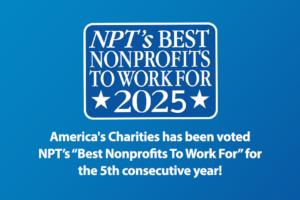Ronita Mohan, Content Marketer, Venngage | May 19, 2020
Nonprofit Continuity: 5 Steps for Surviving a Crisis
The current coronavirus pandemic has put nonprofits in a difficult position—revenue generation, staff needs, and donor demands are all being impacted.
While it can seem dire, there are a few steps that nonprofits can follow to ensure that they survive this crisis and come out at the other end with the ability to thrive.
We outline five steps nonprofits can follow to survive this crisis and any others that come their way.
Step 1: Adapt Internal Structures
During this pandemic, one of the significant changes has been in the way we work—both for-profit and nonprofits.
A number of nonprofits have had to close their physical offices, moving to remote working modes. Organizations that have remained open have had to take special measures to do so.
Some institutions have had to take the unfortunate step of furloughing employees, dismissing them temporarily, or reducing their wages.
These changes not only impact the way nonprofit organizations function right now but also how they will continue to work in the future.
We break down how these three areas can be managed to ensure nonprofit continuity.
Protective Equipment
Institutions that have been deemed essential or are able to remain open in some capacity should ensure they have the correct protective equipment for staff, the workplace, and donors.
Protective equipment is at a premium—with most being allocated to health services, understandably.
If it isn’t possible to equip all staff with masks and gloves, it is imperative that organizations develop workarounds that ensure workers’ health and safety, or simply do not ask their staff to work for the time being.
This will affect revenue generation, but the safety of staff and clients’ needs are paramount.
Remote Accessibility
Infographic source: Venngage
Most companies have managed to move into a remote working model—employees are able to either take work equipment home or use their own laptops to use remote work tools.
While the technology is available, making it possible for everyone to continue their working routine within their homes comes with its own challenges.
Security needs to be taken into consideration—when employees are accessing work files, they might need to use virtual private networks (VPNs) and remote servers.
IT will have to set up the systems—and monitor them regularly—to ensure there are no security or data breaches.
Employee Assistance
Some organizations have found themselves in the unenviable position of having to let staff go or cut wages—in an attempt to control their precarious financial situations.
While this is understandable, employees are unlikely to be able to get new or temporary jobs in the midst of this crisis.
Nonprofits that ensure their staff has some monetary benefits to rely on until the end of the crisis will fare better in the long run. Employee Assistance Funds (EAFs) are hardship relief opportunities for moments such as this.
Not only will that help tide employees over, but it will give them some incentive to return to their jobs once the pandemic is over.
And there is goodwill to think of—nonprofits bring a lot to the communities around them and losing long-term trust by treating staff poorly can negatively impact the chances of continuing success.
Step 2: Crisis Communication
Infographic source: Venngage
During a crisis, communication must be prioritized—not just to maintain connections, but also to keep people around the nonprofit informed.
It is important to remember that there are a number of stakeholders involved with nonprofits—donors, employees, suppliers, event managers, and the community.
All of these groups need to be contacted and communicated with on a regular basis.
To ensure that messaging is strong, you can manage nonprofit communications by using visuals like timelines, checklists, newsletters, and presentations.
Your organization needs to be clear about what measures are being taken in the crisis. Some of the areas that need to be addressed include:
- Are you closing your physical offices?
- Will you be shutting down completely or working remotely?
- If your offices are open, will staff get protective equipment?
- What will your hours of operation be now?
- Will fundraising events in the near or distant future be held?
- Will events be held online?
- How can the company be contacted?
Organizations also need to contact their suppliers and third parties—can supplies still be collected and paid for? Can deliveries be organized?
Suppliers might be relying on organizations like yours to continue their business—knowing that a recurring order may be canceled will help them arrange their future finances.
But you also need to keep in touch with your community—inform people of how they can keep themselves and others safe during the crisis.
Share regular updates on the situation and how your company is handling it—if you don’t have information yet, let people know about that, as well.
Being communicative during a crisis is essential for maintaining relationships with your donors, employees, and your community—make it a priority.
Step 3: Risk Assessment
Conducting risk assessments during a crisis can be a challenge—organizations tend to plan for crises at the early stages of their business planning.
But this crisis has proven that even the best-prepared institution can be caught out—nobody in the world was really prepared for this kind of pandemic.
Having said that, there is still room to assess the future of the company mid-way through the crisis.
While this situation is still unfolding, it is important to set some markers and goals for the business with the information at hand.
For instance, at what point will the crisis call for new revenue generation methods? How can staff be retained without draining financial resources?
Organizations also need to examine where the company is in terms of revenue and donor numbers.
Compared to last year, the numbers are likely to be low—but are they low enough to be concerned, or can the current adaptations in the business model be continued?
One also needs to estimate when the organization can get back to full strength—has the pandemic has put a dampener on all of the plans for 2020 or beyond? What will the impact be on nonprofits going into 2021?
Bottom line: going by the current state of affairs, what does your nonprofit have to do to get back into full swing?
A thorough and honest assessment of the situation will help nonprofits avoid unpleasant surprises in the future.
Step 4: Financial Planning
Finances are taking a massive hit during the current crisis which means revenue planning needs to be re-assessed.
Take a look at the accounts as they stand now and take into account any upcoming expenses—you will most likely already have an idea about rent, overheads, and salaries.
What is less certain is the amount of money that you can bring in—with fundraising events and sales being halted or altered due to the pandemic, revenue has likely fallen.
A number of nonprofits have found ways to hold their events online—thus bringing in some amount of revenue.
Not all donors or participants will be interested in the online version of the event—and not every in-person event automatically lends itself to a great online experience.
Could you look into discounting prices or adding value to your event to encourage participation?
Even online events may not be enough to keep nonprofits afloat. You may need to seek some support—what loan options are available to you through your banks and financial institutions?
Governments have been stepping in to provide aid, as well—it behooves organizations to find out whether they qualify and for what amount.
Some communities have also gathered to help out nonprofits around them—if your company can reach out to them for aid, it could help keep you afloat till the end of the pandemic.
There are financial options available to nonprofits during this crisis, but you need to assess your situation and plan accordingly to avail of them.
Step 5: Preparing for the Future
This pandemic has been unprecedented in so many ways—but it may not be the last one the world faces.
Nonprofits that learn from this crisis and plan for the future—for another crisis like this one or, at the very least, for the shutdown of certain regular facilities—will undoubtedly fare better in the future.
Implement methods for the organization to work within and without your office space. Look into digital options for communication, revenue generation, and remote work.
Examine the remote communication strategies that you have used thus far to understand what did and didn’t work.
Update your current nonprofit continuity plan with what you have learned during this period—even if the exact same crisis doesn’t happen again, at least you will be prepared.
Thoroughly examine your budget—when you are coasting, you don’t need to concern yourself with trivialities. But the situation has changed, so you need to look at your finances objectively.
Five Steps to Success
Preparation is the key to making it through this crisis period—for nonprofits and other organizations.
The above five steps will help nonprofits continue their business not just in the immediate future, but also in the far future.
This crisis is unprecedented, but it doesn’t mean that your company needs to buckle under the pressure of it. You can come through, stronger than ever.
About the author: Ronita Mohan is a content marketer at Venngage, the online infographic maker and design platform. Ronita regularly writes about digital marketing, nonprofits, and small business growth. Twitter: @Venngage

Get Resources and Insights Straight To Your Inbox
Explore More Articles
For Fifth Consecutive Year America’s Charities Named ‘Best Nonprofit To Work For’
Washington, D.C. – April 1, 2025 – America’s Charities, the nonprofit that mobilizes the power of giving as a leading provider of volunteering, workplace giving,…
Read ArticleWorkplace Fundraising + Volunteering Summit (April 2nd and 3rd, 2025)
Join us in attending this virtual summit! The America’s Charities team is joining up with other leading voices in the workplace giving space for a…
Read ArticleThe Time to Act is Now
The results of the 2024 National Assessment of Educational Progress (NAEP) are in, and the findings are, in a word, heartbreaking. This assessment serves as…
Read ArticleGet Resources and Insights Straight To Your Inbox
Receive our monthly/bi-monthly newsletter filled with information about causes, nonprofit impact, and topics important for corporate social responsibility and employee engagement professionals, including disaster response, workplace giving, matching gifts, employee assistance funds, volunteering, scholarship award program management, grantmaking, and other philanthropic initiatives.








